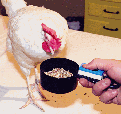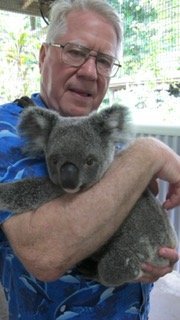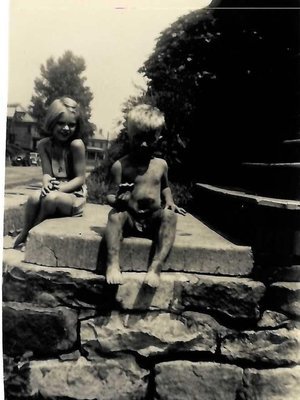FREE RESOURCES

MY CHICKEN WORKSHOPS: Would you like to improve your training skills – mechanics, efficiency, timing? My Chicken Workshops offers you the tools to become a better trainer. CLICK HERE to check out the short video about this latest iteration of operant conditioning chicken workshops.
PATIENT LIKE THE CHIPMUNKS: For a limited time, get FREE ACCESS to a behind the scenes look at the fascinating history of Animal Behavior Enterprises and the life long work by the Baileys and Brelands to further animal training principles. CLICK HERE for free access to the film, Patient Like the Chipmunks. Free access will last through the 2023 ABMA / IMATA joint conference.
MISBEHAVIOR OF ORGANISMS: READ THIS ARTICLE authored by Marian and Keller Breland, the founders of Animal Behavior Enterprises, that offered a ground-breaking new perspective on individual species’ action patters and coined the term “instinctive drift”.
OPERANT CONDITIONING GOES TO THE FAIR: READ THIS ARTICLE authored by Robert E. Bailey, ScD, and J. Arthur Gillaspy, Jr. discussing the history of Animal Behavior Enterprises and the Breland’s use of operant conditioning and its impact on animal training.
OPERANT CONDITIONING MAKES A SPLASH: READ THIS ARTICLE authored by Robert E. Bailey, Jennifer L. Brinegar, and J. Arthur Gillaspy, Jr. discussing the history of the application of Skinnerian behavior technology to marine mammal training.
SMITHSONIAN MAGAZINE: READ THIS RIVETING PIECE on Animal Behavior Enterprises and their top secret government work using highly trained animals as spies during the cold war.
BOB BAILEY, ScD – A BRIEF BIOGRAPHY:

Dr. Robert E. (Bob) Bailey calls himself a systems analyst/engineer. He has 68 years of experience studying and training animals. His academic background is in Physics, Chemistry, Biology, and Engineering. Dr. Bailey designed and built specialized devices, he planned behavior training programs, he taught animal trainers, and he trained animals. His primary mentors were Keller and Marian Breland (later, Marian Bailey), who were students of B. F. Skinner. The Brelands and Baileys demonstrated that animal training can be a technology if practitioners are willing to practice certain principles and procedures based on the science of how animals, and we, learn.

Robert Eugene Bailey was born on October 27, 1936 in Columbus, Ohio, and he grew up in southern California. He completed his BS in Chemistry and Biology at the University of California at Los Angeles in 1959. Active in his studies, Bailey served as a teaching assistant in his second year. In his fourth and fifth year he served as a research assistant for both the UCLA School of Medicine and the Life Sciences Department. In the School of Medicine, he participated in a study on avian imprinting supervised by Bill Beckwith, a student of Konrad Lorenz, the German Ethologist. In the Life Sciences Department, he worked to photograph, capture, catalogue, and care for many plant and animal species throughout the Southwestern USA and in Mexico and Central America. While he was in the field he trained wild wood rats, kangaroo rats, and coyotes to travel prearranged paths. Later, in a laboratory, he trained many species to perform specific tasks. He also participated as a certified SCUBA diver in marine fish field studies in collaboration with California Fish and Game biologists. During this time, he developed and constructed his own equipment for the capture and transport of animals. After graduation and completing active duty with the US Army, Bailey was hired as a Biochemist at the Neuropsychiatric Institute at the UCLA Medical Center. He did bioassay and metabolic studies on phenothiazines and other psychotropic drugs. While at the Medical Center, Bailey noticed an ad for a position as the Director of Animal Training for the U.S. Navy and applied for it. Many experienced dolphin trainers applied for this job. To this day, Bailey maintains that he doesn’t know why he got the job rather than one of the many experienced applicants.
By 1962, he was working as the Director of the U.S. Navy’s animal training program. The program was just beginning to research dolphins at Point Mugu. He directed studies in dolphin sonar and communication. In addition, Bailey conducted research and developed programs for Navy fleet systems using dolphins, seals, and sea lions. Among the research programs was the establishment of behavioral, physiological, medical, and nutritional norms. At the same time Bailey was hired by the Navy Keller Breland was hired as science and behavior consultants. Soon Bob met Marian Breland and Kent Burgess, who was the Director of Training of Animal Behavior Enterprises, the Brelands’ company, which they founded in 1943.
Keller Breland held a very simple class in operant conditioning for the U. S. Navy’s dolphin trainers. For almost 20 years the Brelands had taught animal training using chickens as behavior models. The Brelands’ used local white Leghorn chickens to teach training fundamentals to the Navy trainers. Building on the knowledge that they received from the Brelands, Bob Bailey and Sam Ridgeway, DVM, (the “dolphin doctor” at Point Mugu) developed dolphin-husbandry procedures in the spring of 1963, teaching dolphins to lie still and cooperate, to let trainers put objects into their mouths and blowholes (e.g., for medical procedures), and eventually to let trainers draw blood and give injections. It was also in 1963 that Mr. Bailey initiated and completed the U.S. Navy’s first dolphin open ocean release-and-recovery program.

In 1965, Bailey went to work for Animal Behavior Enterprises (ABE) as Assistant Technical Director. He was placed in charge of ABE’s programs for the Department of Defense and all the marine mammal programs. In addition, he developed equipment for the animal displays and demonstrations, and he wrote manuals and scripts. He also documented ABE’s experimental work. This government work was classified SECRET.
Keller Breland died in 1965. From 1966-1967, Bailey became the research director for ABE. He was responsible for all research programs, whether for commercial purposes or government agencies. He developed several unique devices for animal navigation and communication. Devices included lasers, high frequency acoustic generators, and radio transceivers suitable for implantation in the animals. Bob also developed many trained animal exhibits for ABE, including the popular and entertaining Bird Brain display. Bailey was made ABE Project Manager of the Navy Marine Mammal Program in Key West Florida. In 1968 he became the Vice President and General Manager of ABE, as both CEO and COO, a position that he held until Marian and Bob closed the company to further major projects and programs. In 1976, he married Marian Breland. Bailey attended night school at the local community college in the early 1980’s for two years of computer science and programming. Bailey himself holds four patents for electromechanical devices for animal training and for use in educational and amusement displays.
Bob Bailey’s resume is an impressive collection of state-of-the-art hardware development and construction and innovative behavioral programs. His many years observing wild animals in the field may have given him a unique perspective of what animals did, and why. This translated to more humane and more effective training programs. Perhaps it is Bailey’s depth of experience, and his caring for animals, people, and the technology, that guided him to develop a very effective “Socratic” teaching persona – he questions. He guides with his questioning of the students he is teaching. He allows the student to discover “truth,” gently leading by asking questions requiring critical thinking to answer. Bailey’s teaching methods may be one reason that his “Chicken Workshops” became both internationally famous and popular.
Marian Bailey passed away in 2001, but Dr. Bailey continued the Chicken Workshop classes until 2016. Bailey still lives in Hot Springs, Arkansas. He is semi-retired, but still gives a lecture from time to time.